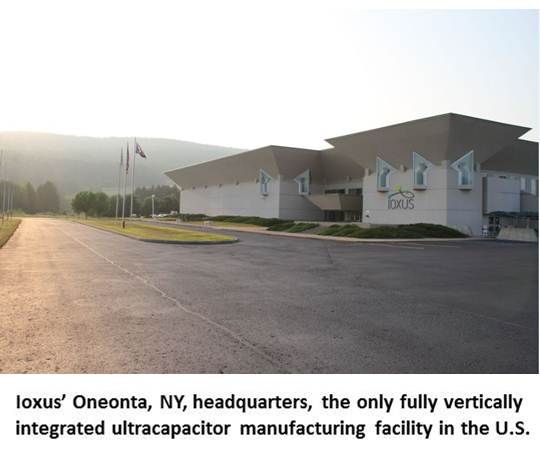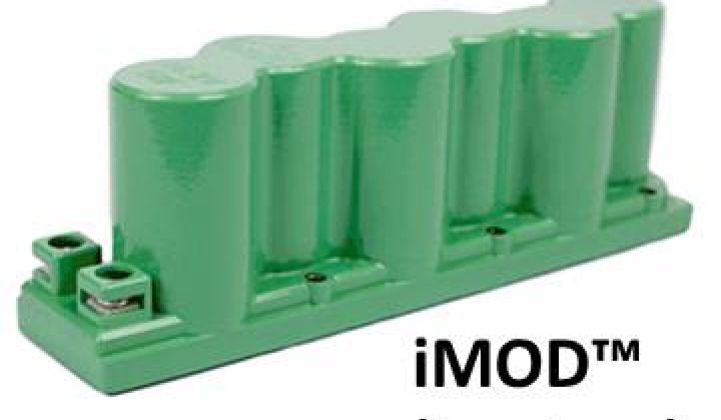Ioxus has created an ultracapacitor module that will relieve its customers of the work of harnessing ultracap cells.
A proprietary set of Ioxus technologies balances cell performances within the module. “It’s like having multiple horses pulling a sleigh and all the horses pulling in the same direction,” Ioxus CEO Mark McGough explained. Better than any such effort to date, according to McGough, Ioxus power electronics technologies harness ultracaps and balances the cells with lower equivalent series resistance, which he said translates to lower heat generation and higher power output.
Ultracapacitors, McGough explained, are “higher powered than any battery and charge more rapidly than any battery. You can charge our product fully in a matter of seconds.”
Ultracaps also, according to McGough, have “a much higher cycle life than a battery. They can be cycled a million times, shallow or deep. And they operate over a wider temperature range, higher and lower.”
The advantages come, McGough explained, because “ultracaps store energy [in a manner that is] fundamentally different than a battery. A battery stores energy with a chemical reaction. We store energy with a static charge that is resonant over a large surface area of material in the construct of the product.”
This creates “a very high capacitance,” an “ultra” capacitance, “which produces a million times higher power” than standard capacitors. Instead of the millifarads [thousandths of a farad] of traditional capacitors, McGough said, “we have products roughly the same size that are 100 farads to 3,000 farads.”
More than a better capacitor, this makes ultracapacitors a sort of better battery. The product “is used as a replacement and improvement on battery applications,” McGough said. Primary applications are in wind turbines, LED lighting systems and hybrid cars. “Elon Musk -- a guy that built a car company, Tesla Motors, based on battery technology -- will tell you that ultracapacitors, not batteries, are the future for hybrid cars.”
Our products range from something the size of a salt shaker to something the size of a can of beer, and, McGough said, “roughly 85 percent of the applications are in the form of a module.” With the new iMOD module, “the customer has a snap-in solution.”

Ultracapacitors have become the power source of choice in wind turbine nacelles, where they power blade pitch control, the positioning of the blade in the wind.
McGough said Ioxus supplies makers of “multiple megawatt turbines, 1.6 megawatts and up,” though confidentiality agreements prevented him from naming the manufacturers.
Though wind turbine blades are long and awkward to reposition, it is vital to be able to adjust them quickly to allow them to grab useful winds. It is even more vital to quickly get blades turned out of potentially damaging winds. Ultracaps are ideal for such quick bursts of work.
Manufacturers use Ioxus ultracapacitors in a variety of combinations. With iMOD arrays, the engineering needed to achieve whatever blade-moving power the turbine-maker wants will be more affordable because “they don’t have to become experts in cell balancing, one of our core competencies,” McGough said.
“There is a significant amount of money involved for turbine makers in wiring ultracapacitor cells together,” McGough said. It requires expert design and engineering skills. “Instead of dealing with 60 cells and the power electronics, you have the ability to install six modules, each with four simple hold-down screws, and they terminate in a simple bus bar structure,” McGough said. “It’s snap-and-go.”
And, he added, “it’s more rugged.” The module, he said, screws into the turbine’s superstructure. That is crucial in a demanding, high vibration environment like a wind turbine nacelle.
Ultracaps, according to McGough, present significantly fewer materials challenges than batteries. They are “composed of some of the most common materials on earth, mainly carbon, which we buy in powder form, and aluminum, which we buy in sheets or in rolls.” Because they contain small amounts of electrolytes -- but no rare earth or toxic materials -- Ioxus provides a recycling service.
An individual ultracapacitor is presently the power supply in today’s hybrid car “start/stop” application. When a hybrid vehicle comes to a stop, the internal combustion engine (ICE) shuts down, dramatically reducing fuel consumption. It is restarted by the electrical system, powered by an ultracapacitor that is recharged when the ICE resumes powering the vehicle.
But, McGough said, “iMOD products are being tested for a variety of automotive applications.”
The most important of these is extending the life of hybrid electric vehicles’ batteries. In conjunction with an iMOD ultracapacitor array, McGough said, the standard five- to seven-year battery life could be doubled. “Down the road, companies like Ioxus will improve the energy density of ultracapacitors,” McGough added, and “open up power train applications in an EV or HEV.”
Ioxus is well funded. It just completed -- in April, "with ease" -- a series B financing round of $21 million. It is backed by GE, Conoco Phillips, NRG Energy, Alstom, Braemar Energy Ventures and Northwater Capital, among others.
But “there are other players” in ultracapacitors, McGough noted. “We’re not the oldest and we’re not the biggest.” One of the oldest and biggest, he said, is Maxell Technologies, whose ultracap business he started in the 1990s. “The reason I’m the CEO of Ioxus,” McGough said, “is that I have a strong belief in the Ioxus technology, both current and future.”
Companies that don't build ultracaps include EEStor.



